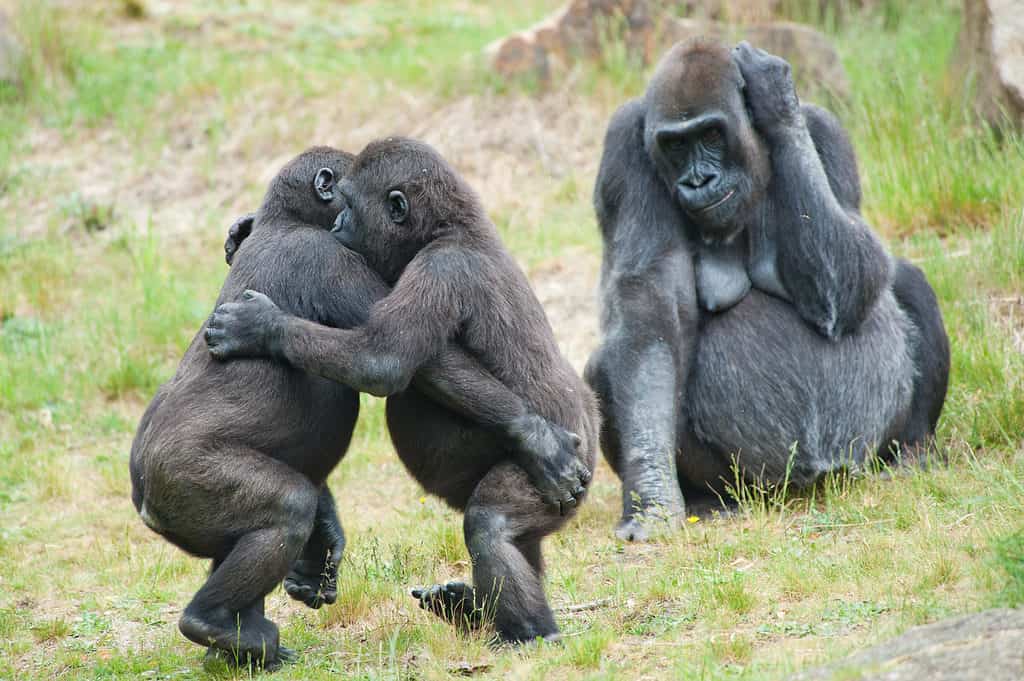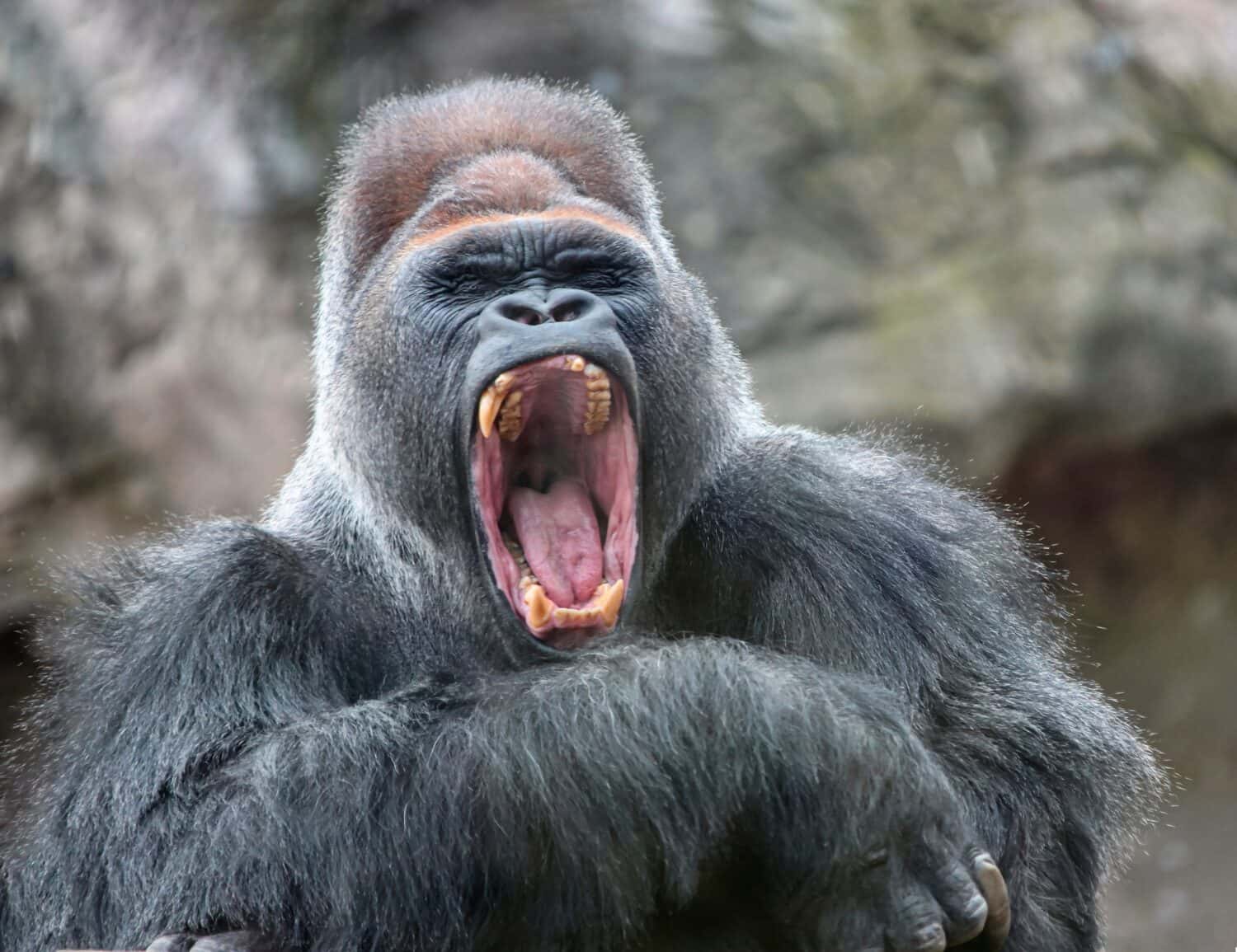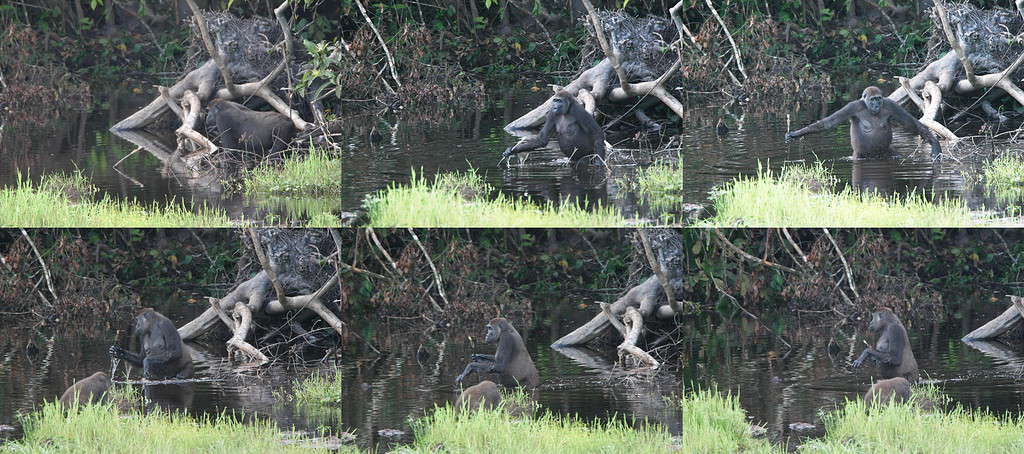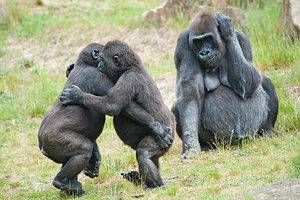The Gorilla genus comprises two closely related primate species native the tropical forests of equatorial Africa. These species are the eastern gorilla (Gorilla beringei) and western gorilla (Gorilla gorilla). As fellow Great Apes (family Hominidae), we know gorillas are one of the closest living relatives to humans. But just how smart are gorillas? Read on to find out what we’ve learned about gorillas and intelligence.

When we watch gorilla children play, it’s hard not to see the similarities to human children!
©Eric Gevaert/Shutterstock.com
A Summary of the Animal’s Mental Abilities
As with all the great apes, gorillas are highly intelligent animals with advanced cognitive abilities and complex social structures. They develop strong family bonds, display individual personalities, and clearly have rich inner emotional lives. They are capable of both advanced spatial and temporal reasoning, as well as tool use. Gorillas also have their own complex system of intraspecies communication. Furthermore, they have demonstrated the ability to learn interspecies communication.
Cognitive Capabilities: Understanding Gorilla Problem-Solving Skills and Learning Aptitude
Gorillas employ a combination of gestures, facial expressions, and vocalizations to communicate with each other. Like other non-human primates, gorillas are not anatomically capable of actually “talking” the same way we are, though. However, gorillas and humans have still found other ways to communicate with each other.
Gorillas can use their spatial and temporal reasoning skills to solve problems. This includes optimizing foraging and travel routes and locating hidden items. They also utilize episodic memory; that is, they can think about the past. However, their level of self-recognition is still a matter of debate (see “Past Discoveries and Studies on Gorilla Intelligence” below).
Intelligence in the Animal Kingdom: Comparing Gorillas to Other Species
The great ape family includes humans and all our other closest living primate relatives: chimpanzees, bonobos, gorillas, and orangutans. Humans naturally consider great apes as perhaps the smartest of the non-human animals on account of this closeness of relation.
While gorillas are the overall largest of the great apes, they rank a distant second to humans in brain weight. In fact, the average human brain weighs more than twice as much! Furthermore, when we consider brain to body weight ratio, gorillas actually rank last. Gorillas are also more distantly related to us than our two very closest relatives, the chimpanzees and bonobos. These facts, combined with observing that chimpanzees and bonobos seem more naturally curious and inventive in comparison to their gorilla cousins, has often led to humans rating gorilla intelligence as slightly lower.
However, simply ranking relative intelligence levels is difficult to do. Rather, it is better to think of each kind of great ape as possessing a unique flavor of high intelligence that evolved to be well-adapted to their specific circumstances. For example, the fact that wild gorillas do not use tools as often as chimpanzees should not automatically be taken as an indicator of lower gorilla intelligence. Rather, it could be a natural consequence of their different habitats, diets, and relative physical strengths. Think about the fact that gorillas don’t need to fashion tools to crack open nuts, for instance; they can simply break them with their powerful teeth! Likewise, gorillas are primarily vegetarian, and thus don’t usually need to create hunting or fishing tools.

A gorilla’s impressive teeth are strong enough to easily bite through nuts that other primates must fashion tools to crack open.
©Okyela/Shutterstock.com
Past Discoveries and Studies on Gorilla Intelligence
Tool Use
Tool use in captive gorillas is well documented. For example, a 1995 study reported on captive gorillas using sticks as both weapons and hygiene aides. A 1999 study also detailed captive gorillas utilizing sticks to obtain out-of-reach food. The Prague Zoo has also observed their gorillas engaging in extensive and varied tool use. This included using crates as stools, tables, drums, and weapons. They even saw two of them making “slippers” out of wood wool!
It wasn’t until a 2005 study that tool use was first reported in wild gorillas, however. Researchers documented a gorilla using a branch as a walking stick to test water depth and assist crossing a pool. They also observed a second gorilla using a long shrub trunk both as a stabilizing stick and as a bridge. This study made the important observation that, “In contrast to information from other great apes, which mostly show tool use in the context of food extraction, our observations show that in gorillas other factors such as habitat type can stimulate the use of tools.”

This wild female gorilla used a walking stick while crossing bipedally through deep water.
©Public Library of Science / CC BY 2.5 – License
Self-Recognition: Mirror Tests
Multiple studies have reported on the failure of gorillas to pass the so-called “mirror test” of visual self-recognition. These include experiments on different individuals conducted in 1981, 1982, and 1998. However, some researchers suggest that the mirror test may not be appropriate to use on gorillas, at least not without significant preparation. This is because wild gorillas are naturally averse to eye contact, as it is seen as a sign of aggression. More recently, experiments conducted in 2006 and 2007 reported that captive gorillas who were both well-acclimated to humans and given time to become familiar with mirror use could in fact pass the test.
Language and Communication
A third gorilla who passed the mirror test was also the subject of the longest-running great ape language experiment on record. This was none other than Koko the Gorilla (1971-2018). The popular press reported widely on her language learning exploits, and she became one of the world’s most recognizable animal celebrities.
Florence Patterson, co-founder of The Gorilla Foundation, raised Koko herself from the age of 1. Patterson served as both instructor and caregiver to Koko for the rest of her life, simultaneously teaching her sign language and speaking English to her. Over the span of 45 years, Koko developed a working vocabulary of over 1,000 signs and an understanding of about 2000 words of spoken English. Koko was later joined by a second gorilla, Michael (1973-2000), who came to the foundation at the age of 3 as a wild orphan. He too learned about 600 signs before his untimely death in 2000.
It should be noted that the Gorilla Foundation’s program, while popular with the public, has always been contentious within the scientific community. Conclusions about to what degree Koko and Michael learned things like actual language syntax remain disputed to this day. Nonetheless, their fame clearly helped raise global awareness of both the impressive cognitive ability and immense emotional capacity of gorillas. This, in turn, helped fuel conservation efforts to protect Koko and Michael’s endangered wild relatives. As one of our closest relatives in the animal kingdom, there is little doubt they are indeed one of the smartest animals on the planet!
The photo featured at the top of this post is © Ondrej Prosicky/Shutterstock.com
Thank you for reading! Have some feedback for us? Contact the AZ Animals editorial team.





